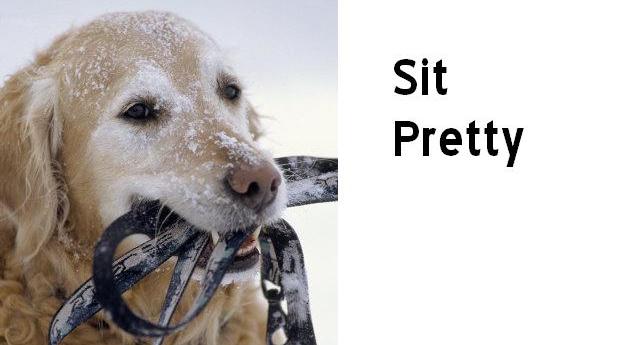This one is a pet peeve of mine and is related to the reasons why the 'choke chain' is on the forbidden list at most dog training schools.
The choke chain in the hands of somebody who knows how to use it humanely is not going to do any damage to the dog. In fact, I've trained three dogs using choke chains. No biggee.
It is a biggee problem now, because apparently vets and various obedience clubs have discovered that the choke chain in the wrong hands damages the dogs' throats and parts thereof. Rather than teach people how to use the chains properly, most clubs have decided to ban choke chains altogether. The argument is that the majority of people who go through basic obedience training tend to be a bit airheaded when it comes to how they handle their dogs when not under an instructor's supervision.
I guess I'm fine with that move, but wish that these clubs would address the reasons why so many dogs are now having throat problems thanks to choke chains. It isn't the choke chains themselves, or even the dogs. It's the owners improperly using this training tool.
The way I look at it, the problems are:
A. People don't know how to put choke chains on their dogs right
B. People don't know how to correct the dogs with choke chains
C. People don't realize that a choke chain should not be used except when training
The correct way to put a choke chain on your dog:
Think of the letter P. That is how the loop should look when you put it on the dog. When you correct the dog, it is a quick pop/release.
When people put the chain on backwards (think backwards P), the chain will not release properly after corrections. It stays tight around the dog's neck.
The proper way to correct your dog:
When you feel your dog pulling or not paying attention, you do a QUICK pop on the chain towards your left leg or hip and then release. This should be a moderate pop, nothing that yanks your dog over backwards. And you release instantly after the pop. You do not want to keep pulling on the chain, because most dogs learn to pull right back, causing the chain to tighten up WAY TOO MUCH around their neck causing that damage.
Again - your goal is to get your dog's attention. So you pop, give a verbal command (like 'Heel!' 'Walk Nice!' or 'Pay Attention!'), and release.
There is a time and a place for using a choke chain:
This is my pet peeve of the century - when I see people taking their dogs out for walks with those choke chains instead of regular collars. The chains will be knot tight and grinding away at the dogs' throats as they pull every which way to mark everything and checks out smells.
There was this one time when a neighbor was out walking her female lab. This dog was built like a tank and twice as strong. When she saw me and my dog coming up the street, the dog pulled so hard she broke the choke chain.
Dudes.
The collars are for training only. You use them in controlled environments where you can train the dogs not to pull. If you do this right, you can put your flat or rolled collars on the dogs when they go for walks and you should be able to use those normal and harmless collars to remind the dogs to calm down.
That goes into my other semi-rant - and keep in mind I'm approaching this from the show obedience side, where the heel is this religious and holy thing that must not be confused ever with the casual walk around the block.
When you tell your dog to heel, you expect the animal to walk on your left side and do this synchronized walking thing with you, with their focus up and only on you. This is ideal when you are walking into stores or otherwise indoors where you don't want the dog to be all over and bothering other people.
When you are outdoors and taking your dog for a walk - dudes, it is just cruel expecting your dog to be glued to your side and paying strict attention to you. Keep in mind most dogs regard the evening walk as their time to be dogs. This means strutting down the street taking in all of the scents, stalking the odd squirrel it sees in somebody's yard, waggling at other walkers, and also peeing on everything in sight.
Let's say you have a young dog, and want to preserve the sanctity of the 'heel' word for those occasions when you are walking around a store and don't want your dog paying any attention to other dogs or people or smells around the store - use the 'heel' word only then. If you have a choke chain and know how to use it, I'd probably save it for times like this - to remind the dog that he is working.
When you are out walking the dog, it is too much to expect the animal to do a perfect heel the entire route. For that matter, it is too much for people to be paying attention to their dogs that entire walk. So they might tell the dog to 'heel' and then, while they are distracted or daydreaming, allow the dogs to pull and do whatever the heck they want. This renders the 'heel' word meaningless to the dogs.
What I generally do with my dogs is teach them I expect them to walk nice - all the time. I don't put up with pulling or lunging, period. The dogs are trained to walk nice up and down the hallway of my house, and then in the front yard - in a controlled area.
I use the choke chain only when I'm training/working with my dog. This way he recognizes the choke chain as a "training+treats" cue. There is that reminder that I expect his full attention, and of course he knows he'll get treats and praise when he's perfect.
When I put the flat collar on my dog, he recognizes that as "walking/car ride" cue. Means he gets to be as goofy as he wants, but thanks to the earlier training he knows the pop and sharp verbal correction (Walk Nice!) from me means I expect him to walk nice.
The only exception really is if you have one of those aggressive type dogs who responds only to the choke chain or even a pronged collar when he sees something it wants to attack or eat. In which case, I'd probably put both a choke chain and a regular collar on the dog, and I'd be prepared to switch over to the choke chain or pronged collar if I see something ahead that I know he will go after. And I would use the choke chain/prong as a correction and otherwise do what I can to diffuse the situation and maintain control.
I have never owned a dog like this, but acknowledge that they do exist. All the same, a special collar should not replace training. One of my neighbors owns two young but large boxers who are a bit like this. They are not aggressive, but they are super-active and strong-minded. Although she is petite and could be dragged if they set their minds to taking off with her, she is an excellent trainer and more than capable of handling both dogs at the same time - and that is with flat collars.
Besides the training, she takes certain measures to diffuse situations that could get her in trouble. One is walking at the times of the day when there aren't so many dogs and people out and about. If she does come upon other walkers, she quickly sits her dogs and maintains a hold of their collars until the distractions pass by.
Anyhoo, a quick review:
Heel - when you use this word, make sure you follow up and make the dog heel (dog is glued to your side and matching your pace perfectly) until whatever point when you release them and let them walk off and be dogs.
Walk Nice - for when you are out and about and don't expect the dog to be glued to your side and performing a perfect heel while you yourself would rather be daydreaming or talking with friends. Those two words are reminder enough to the dog to stop pulling or winding the leash around your legs and/or marking everything in sight.
Choke Chains - Are a great tool, if they are used correctly. If used incorrectly, you could have a dog like my neighbors' dog who broke that chain like it was nothing before charging my alarmed beast. Or at worst, you might permanently damage your dog's throat, larynx, thryroid, and whatever else and incur mondo vet bills.
Know you Dog - is the most important concept a dog owner and trainer needs to wrap their head around. Everybody's dog is different. Learn the worst that your dogs can do, and figure out how best handle them.
Confession:
Jack's worst is he has apparently set his mind on living up to his name. When I'm out walking with him, I steer to the far side of the road when I encounter other walkers. Give him a little encouragement (dog barking at him, people cooing over him, etc), and he will jump three feet in the air and then look for something to pick up and shake in his mouth (usually his own leash). And yes, that is my obedience trained dog that I hope to show soon....


No comments:
Post a Comment